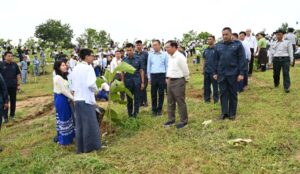Min Aung Hlaing Stresses Earthquake-Resilient Reconstruction Following Mandalay Quake

Yangon, The Gulf Observer: Chairman of the State Administration Council and Prime Minister Senior General Min Aung Hlaing has emphasized the importance of incorporating earthquake-resilient designs in the reconstruction of government buildings damaged by the recent Mandalay earthquake, highlighting the need for long-term structural safety and durability.
During an inspection visit yesterday afternoon, the Senior General, accompanied by Council Joint Secretary General Ye Win Oo, Union ministers, the Chairman of Nay Pyi Taw Council, and other senior officials, assessed the extent of damage at the Supreme Court of the Union and the Ministry of Labour. Both institutions sustained significant structural damage and have been identified among the most heavily affected buildings in the capital.
At the Supreme Court, the Senior General observed ongoing efforts to remove hazardous debris, the condition of the office buildings, and the temporary relocation of administrative functions to prefabricated offices. He provided on-the-ground guidance to officials overseeing the recovery operations.
Similarly, during his visit to the Ministry of Labour, the Senior General inspected damage along the circular road, evaluated temporary working arrangements, and reviewed the condition of various office rooms. He acknowledged the uninterrupted continuity of official work despite the disruptions and provided further instructions for safety and recovery.
The Union Minister for Construction presented a detailed plan for phased reconstruction, including the dismantling of unsafe structures, implementation of safety measures such as a retaining wall on the western side of the Ministry, and close consultation with engineering experts.
Responding to the briefing, Senior General Min Aung Hlaing stressed the urgent need to consult geotechnical and construction experts, conduct thorough soil testing, and apply precise structural calculations to ensure that newly constructed buildings are resistant to future seismic activity.
“The Supreme Court and the Ministry of Labour buildings were among the hardest hit,” he noted. “We must ensure that all future construction is grounded in sound scientific and engineering principles to safeguard lives and institutional stability.”
He further instructed authorities to expedite the initial stages of reconstruction and adhere to established timelines to restore full functionality to the affected ministries without compromising safety standards.
The inspection underscores the government’s commitment to prioritizing resilience and preparedness in infrastructure development, particularly in the wake of natural disasters that threaten both public safety and administrative continuity.


